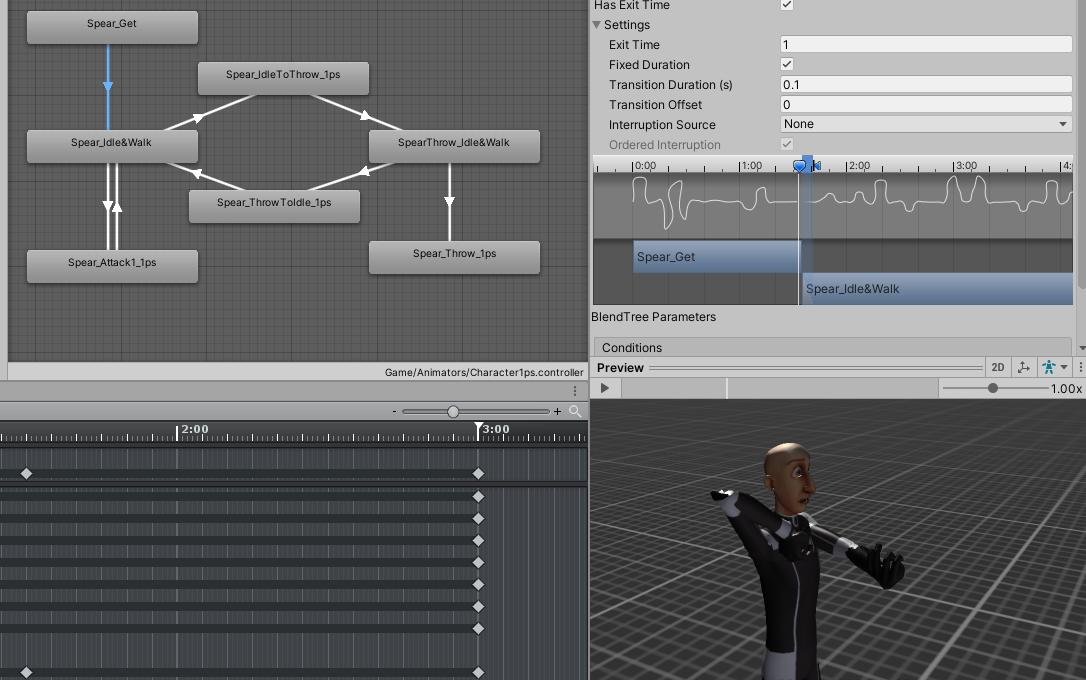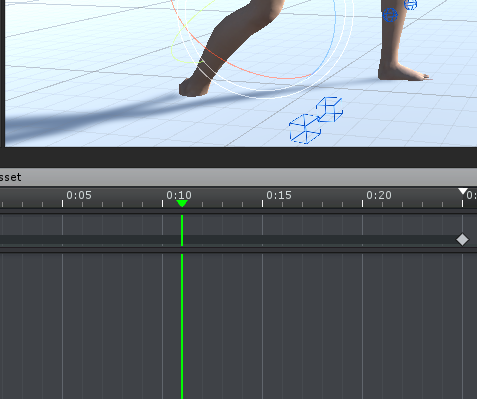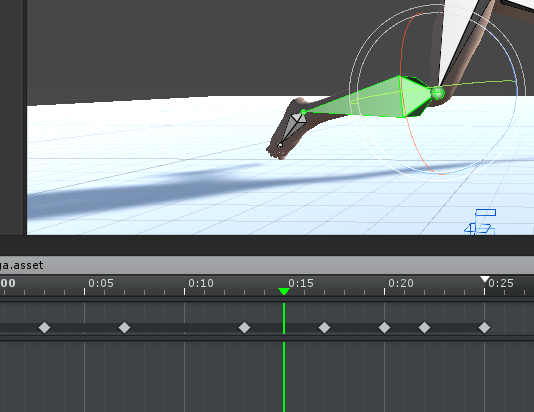 Anchoring the bones
Anchoring the bones
Hello!
Is anyway to anchor bone in edit mode animation?
I have existing animations, but I would like to change them so that the character carries something. I don't want to change that for every frame.
Something like (0:12 to 0:13).

Greetings,
David

Hi David,
thank you very much for reaching out.
Yes this is possible and is called "IK Pinning". Please first watch the child-of constraint video tutorial (it is the underlying system that enabled the IK pinning functionality), then watch the IK Pinning video tutorial:
Please let me know in case you have any follow-up questions.
Best regards,
Peter
 Do armature transforms no longer get modified in editor?
Do armature transforms no longer get modified in editor?
I used to use a tool that would use the UMotionCallback to update the transform of props onto the hand bone transform so that I could preview held props while editing an animation. It seems that the armature transforms are no longer modified by the clip editor. Did something change with Unity/Umotion versions?

Hi,
thank you very much for your support request.
Related to the callback mechanism, nothing changed (to my knowledge). I also did a quick test and for me everything is working as expected:
using UnityEngine;
using System.Collections;
public class TestScript : MonoBehaviour
{
public Transform TestBone = null;
// Use this for initialization
public void MyCallback ()
{
TestBone.Rotate(0, 90, 0);
}
}
Assign this script to your character. Then assign any bone to the "TestBone" field. Make sure that UMotion calls the "MyCallback". Your script should get called and adds another 90 degree rotation to the bone.
PS: Oh you probably mean that the visualization of the bones is not updated according to the changes done via the custom script? That's currently by purpose, as the scripts are called after UMotion updated everything and indicates that the changes are coming from a script, not from UMotion.
Best regards,
Peter

 animator transition bug?
animator transition bug?
I have three animations created in UMotion. Get weapon, Idle weapon and Walk weapon. Also i have other animations but for now it doesnt metter. Bug apears in transitions. For example between these animations. Idle and Walk in blend tree. On screen you can see where transition is, and how looklike person before transition. Then, in transition, hands (IK standart UMotion setup) rotating around to same rotation. (in next screens) They just make 360 rotation for no clear reason for me.


 Just picked up Umotion - Newbie Question on Pasting Start and Stop states to create clip- Melee Draw Sword
Just picked up Umotion - Newbie Question on Pasting Start and Stop states to create clip- Melee Draw Sword
Just picked up the asset - Looks really good! Questions: (IK Setup-Humanoid-Auto Key=> Generate) -For first testing I took 2 Animations, One a Melee Pose Idle and the Other a Locomotion Idle.
I created a new "Clip" and have both these animations imported. I just want to start with the Locomotion idle pose state and end state be the Melee Pose State (Drawing a Sword Later). When I select the Melee Pose Animation, Select the entire body, Change to my Clip and move to 2:00 and hit CNTRL-V to Paste it does nothing? From what I understand Umotion after this end state paste (and Beginning state paste) will create the clip with the humaniod moving from idle state to the melee ready to draw sword state? I guess I am stuck on why I can't paste the beginning and end states? Sorry, New to working in animations like this. Excited though :)

 Isolate Selection
Isolate Selection
Hi!
Would it be possible to have the selected bones be isolated in the properties menu? What i mean is, in dopesheet or curves, to have only the bones that have been selected in the scene view be visible. So if I'd select the two hip bones, all other properties would be hidden (until anything else is selected). Having this as a toggleable feature would be amazing!
I think it would make it a lot easier to work, for example when two properties you want to sync/time with each other are very far away from each other on the list (making you have to scroll up and down all the time to see them)
Thanks for the excellent tool, it makes animation so muc faster for me as it is :)

Hi Felix,
thank you very much for sharing your idea.
I think this would indeed be a useful feature. I've took a note in my ideas for the future list, but can't promise anything right now.
Thanks for your nice words, I'm glad you like working with UMotion. Don't hesitate to contact me in case you have any other ideas or have any questions.
Best regards,
Peter
 Pose to Pose > Feet going through floor midway through. Best technique?
Pose to Pose > Feet going through floor midway through. Best technique?
Hello,
I'm trying to simply transition a character between two simple poses.


When I scrub between the two states, the character's feet go through the floor.

What's the best technique to fix this sort of thing? Simple keyframing like I've done using this additive layer?

Or is there a much better technique? I've tried messing around with IK, but that always seems like the wrong route to go down if you're trying to edit the position of body part that is already being animated in the raw file.
I think UMotion is terrific btw, one of the best tools I've seen for Unity! I just it had a lot more tutorials dealing with simple stuff like this (is it simple???) for the more amateurish amongst us :)

Hi,
thank you very much for your support request and thanks for the nice words. Really appreciated.
I would say this is a typical IK use case, as with IK you can directly specify the trajectory of the foot/ankle (via the position of the IK handle). Setting up IK is rather straight forward using the IK setup wizard (when using humanoid, the IK setup wizard's default settings usually don't need to be changed).
You have the possibility to either only use IK at a specific part of your animation (with the "FK/IK Blend" channel you can fade between FK/IK, and using the "Set IK to FK" button you can sync the IK handle with the current FK rig), or you can convert the whole existing animation to IK using "Edit --> FK to IK Conversion" (please note that this conversion might have small imperfections that you may need to correct by hand again).
All the details about IK are shown in this video tutorial:
Please let me know in case you need any further assistance.
Best regards,
Peter

 Interface access current edit bone data
Interface access current edit bone data
I wrote a ruler&protractor script try to catch bone's transform variable, but skeleton in scene did not actually move, seems play graph only.
it'll be great to have a window access editing frame data

Hi,
thank you very much for sharing your idea. I really appreciate that.
When you've assigned a character to the Pose Editor, any changes you do externally (e.g. via a custom script) to any of the bones/transforms of said character are going to be overwritten by UMotion every time UMotion updates the pose. The only way to change the pose of your character is via UMotion's callback mechanism. The callback is called every time UMotion finished updating the pose, thus allows your script to add modifications on top of it. For more information, please check the manual at "Pose Editor / Options" headline "Extending UMotion".
UMotion also has a dedicated UMotion API that gives scripting access to some features of UMotion. Unfortunately, the bone data is currently not exposed via this API. I've took a note to expose this in the future, but can't promise anything as of now.
Please let me know in case you have any follow-up questions.
Best regards,
Peter

 RootMotion problem
RootMotion problem
Somehow humanoid's hips transform show "different difference variable" between local coordnate and global coordnate,which cause rootmotion inaccurate.
"different difference variable">>between two frame FrameStart and FrameEnd, localposition take 0f difference at Y-axis,but once swtich to global unit, it takes 0.01f difference at Y-axis, same problem also happen on rotation

Hi,
thank you very much for your support request.
Animations only use local coordinates internally. The world space coordinate you see in the tool assistant window, is the local coordinate converted to world space. Due to floating point inaccuracies (especially noticeable if your character has huge scaling or is far away from the scene's center), the displayed value can have small errors.
Please let me know in case you need any further assistance.
Best regards,
Peter

 QOL - Set the Animation Type on exported FBX files
QOL - Set the Animation Type on exported FBX files
This is a small thing, but when outputting to FBX uMotion should automatically set the animation type based on the uMotion project's animation type.

Hi Mel,
thank you very much for sharing your idea.
This is not implemented by purpose. There are two reasons:
First of all, when exporting a humanoid project (and you want to use the animation as humanoid) it is highly recommended to use the "Update Existing File" mode to write the animation into the humanoid character's FBX file (--> the FBX is already set as humanoid). If you export your animation as a new separate FBX instead, then the humanoid avatar setup isn't created in an optimal way by Unity, leading to errors in the resulting humanoid animation.
Furthermore, it should be up to the user how he wants to use the FBX animation. It can be a legit use case to export a humanoid animation to FBX, but then use it as generic for example.
That's way I opted for a manual way.
Best regards,
Peter

 UMotion In Practice Link Death
UMotion In Practice Link Death
I am new to umotion, so im still watching the umotion tutorials, I just peeked at the , FPS UMotion In Practice, And for the hands there is a link Whole Project. This one is also death. I need to watch this tutorial in the futher.

Hi,
thank you very much for letting me know. I've updated the link in the video description, it should be working again.
Don't hesitate to contact me in case you find any other dead links.
Best regards,
Peter
Customer support service by UserEcho
